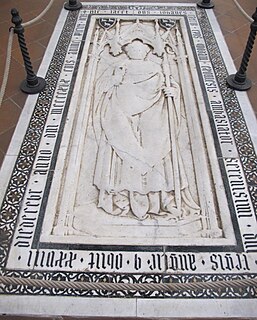Related Research Articles
Simon de Langham was an English clergyman who was Archbishop of Canterbury and a cardinal.
Marmaduke Lumley was an English priest, Bishop of Carlisle from 1429 to 1450, and Knight Commander of the Order of St. John of Jerusalem. He was a son of Ralph de Lumley, 1st Baron Lumley and Eleanor de Neville. He was elected about 5 December 1429, and consecrated on 16 April 1430. He was Bishop of Lincoln for a short time before his death in December 1450. He was educated at University of Cambridge and was appointed Precentor of Lincoln Cathedral in 1425. He also became Chancellor of the University of Cambridge in 1427 and was Master of Trinity Hall, Cambridge from 1429 to 1443. From 1446 to 1449 he served as Lord High Treasurer of England. Lumley's tenure as Lord High Treasurer occurred during the Great Bullion Famine and the Great Slump in England.
William Senhouse, also called William Sever, was an English priest, successively Bishop of Carlisle, 1495–1502, and Bishop of Durham, 1502–1505.
Thomas Brunce was a 15th-century Bishop of Rochester and then Bishop of Norwich.
John Fordham was Bishop of Durham and Bishop of Ely.
Cyneweard was an Anglo-Saxon Bishop of Wells. He was a monk of Glastonbury Abbey before becoming abbot of Milton Abbey in 964. He was consecrated bishop of the Diocese of Wells in about 973 or 974, and died in office on 28 June 975. His death is mentioned in the short Old English poem "The Death of King Edgar", which occurs in the entry for 975 of two of the manuscripts of the Anglo-Saxon Chronicle.
Sigar was an Anglo-Saxon Bishop of Wells.

John Barnet was a Bishop of Worcester then Bishop of Bath and Wells then finally Bishop of Ely.
Nicholas Bubwith (1355-1424) was a Bishop of London, Bishop of Salisbury and Bishop of Bath and Wells as well as Lord Privy Seal and Lord High Treasurer of England.
Robert Reed was a Bishop of Waterford and Lismore, Bishop of Carlisle and Bishop of Chichester.
Thomas Polton was a medieval Bishop of Hereford, Bishop of Chichester, and Bishop of Worcester.
Elphege was a medieval Bishop of Lichfield.
John Burghill was a medieval Bishop of Llandaff and Bishop of Coventry and Lichfield.

John Catterick was a medieval Bishop of St David's, Bishop of Coventry and Lichfield, and Bishop of Exeter.

Richard Redman was a medieval Premonstratensian canon and abbot of Shap Abbey, Bishop of St Asaph, Bishop of Exeter, and Bishop of Ely, as well as the commissary-general for the Abbot of Prémontré between 1459 and his death.
John Gilbert was a medieval Bishop of Bangor, Bishop of Hereford and Bishop of St. David's.
Wynsige was a medieval Bishop of Dorchester.
Alnothus was a medieval Bishop of Dorchester, when the town was seat of the united dioceses of Lindsey and Dorchester.
Æscwig was a medieval Bishop of Dorchester, when the town was seat of the united dioceses of Lindsey and Dorchester.
Richard de Wentworth was a medieval Bishop of London.
References
- Fryde, E. B.; Greenway, D. E.; Porter, S.; Roy, I. (1996). Handbook of British Chronology (Third revised ed.). Cambridge, UK: Cambridge University Press. ISBN 0-521-56350-X.